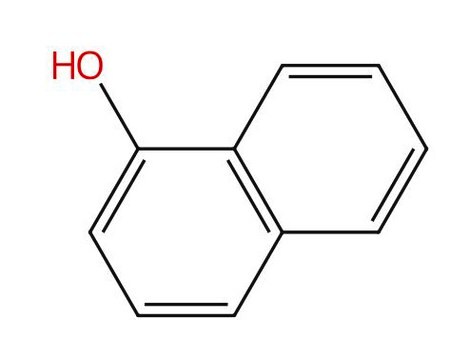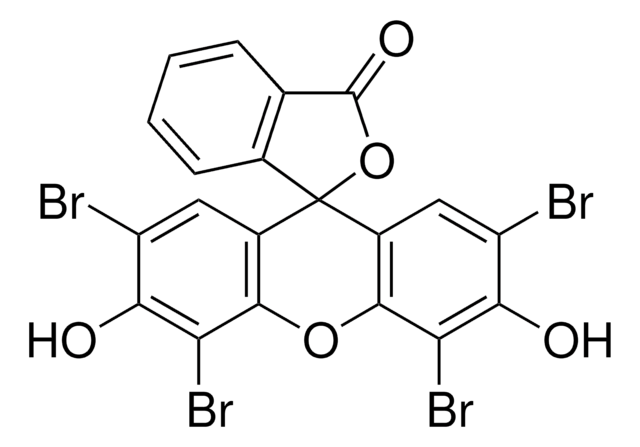33420
1-Naphthol
puriss. p.a., reag. Ph. Eur., ≥99% (GC)
Synonym(s):
α-Naphthol, 1-Hydroxynaphthalene
About This Item
Recommended Products
Agency
USP/NF
reag. Ph. Eur.
Quality Level
vapor density
4.5 (120 °C, vs air)
vapor pressure
1 mmHg ( 94 °C)
grade
puriss. p.a.
Assay
≥99% (GC)
autoignition temp.
1007 °F
expl. lim.
5 %
impurities
≤0.001% heavy metals (as Pb)
≤0.2% naphthaline (GC)
≤0.2% water (Karl Fischer)
≤0.5% 2-naphthol (GC)
ign. residue
≤0.05% (as SO4)
bp
278-280 °C (lit.)
mp
94-96 °C (lit.)
94-97 °C
anion traces
chloride (Cl-): ≤50 mg/kg
cation traces
Fe: ≤10 mg/kg
SMILES string
Oc1cccc2ccccc12
InChI
1S/C10H8O/c11-10-7-3-5-8-4-1-2-6-9(8)10/h1-7,11H
InChI key
KJCVRFUGPWSIIH-UHFFFAOYSA-N
Gene Information
human ... CYP1A2(1544)
Looking for similar products? Visit Product Comparison Guide
Application
- A ′conovenomic′ analysis of the milked venom from the mollusk-hunting cone snail Conus textile--the pharmacological importance of post-translational modifications.: This research underscores the critical role of post-translational modifications in the biological activity of peptides derived from cone snail venom, illustrating the potential for developing novel pharmacological agents using peptide synthesis techniques like those involving Fmoc-Asp(OtBu)-OH (Bergeron et al., 2013).
- Parallel high-throughput accurate mass measurement using a nine-channel multiplexed electrospray liquid chromatography ultraviolet time-of-flight mass spectrometry system.: This paper discusses a breakthrough in mass spectrometry, highlighting a method for high-throughput analysis which could be critical for the characterization of complex peptide products synthesized using Fmoc-Asp(OtBu)-OH (Fang et al., 2003).
Packaging
Signal Word
Danger
Hazard Statements
Precautionary Statements
Hazard Classifications
Acute Tox. 3 Dermal - Acute Tox. 4 Oral - Aquatic Acute 1 - Aquatic Chronic 3 - Eye Dam. 1 - Skin Irrit. 2 - Skin Sens. 1A - STOT SE 2 Oral - STOT SE 3
Target Organs
Kidney, Respiratory system
Storage Class Code
6.1C - Combustible acute toxic Cat.3 / toxic compounds or compounds which causing chronic effects
WGK
WGK 1
Flash Point(F)
257.0 °F - closed cup
Flash Point(C)
125 °C - closed cup
Personal Protective Equipment
Choose from one of the most recent versions:
Already Own This Product?
Find documentation for the products that you have recently purchased in the Document Library.
Customers Also Viewed
Our team of scientists has experience in all areas of research including Life Science, Material Science, Chemical Synthesis, Chromatography, Analytical and many others.
Contact Technical Service












